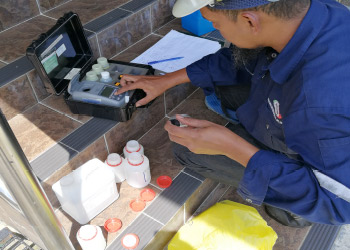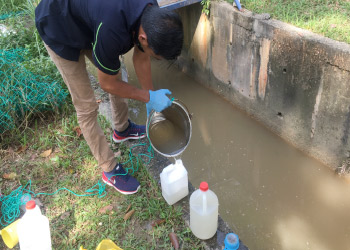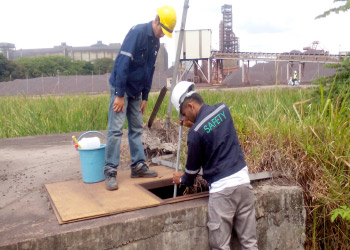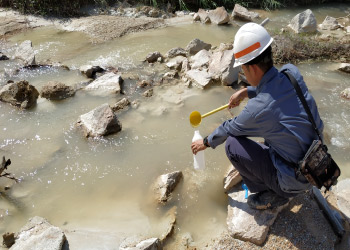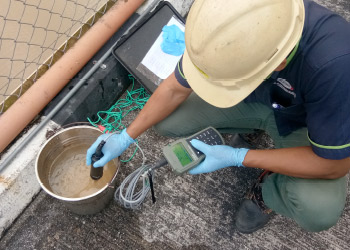
Environmental Services
Noise can be described as unwanted sound. Low levels of noise exposure may not necessarily be harmful. It can be desirable and convey a sense of liveliness in our activities.
However, exposure to elevated sound levels that may lead to adverse effects in humans or other living organisms is defined as Noise Pollution. Exposure to Noise Pollution may come from various sources such as transportation, construction, industrial entertainment and recreational activities. This can lead to various hazardous health effects such as hearing loss, hypertension, sleep disruption, anxiety and psychological dysfunctions.
These harmful noise levels need to be monitored and regulated by the respective governmental bodies such as Department of Environment (DOE) and Department of Occupational Health & Safety (DOSH)
Boundary noise which is also known as Environmental Noise is defined as noise from the surrounding areas of a premise. In Malaysia, Section 23 of The Environmental Quality Act 1974 stipulates that : “No person shall, unless licensed, emit or cause or permit to be emitted any noise greater in volume, intensity or quality in contravention of the acceptable conditions”
In this context, Boundary/Environmental Noise Monitoring is conducted in order to measure the noise levels emitted from the surroundings of an area or premise as per the requirements Department of Environment (DOE) in order to comply with the The Planning Guidelines for Environmental Noise Limits and Control.
We at PROCOMA are accredited by Department of Standards Malaysia (DSM) (SAMM No 516) under the requirements of MS ISO/IEC 17025 to conduct the noise level measurements.
Recommended Permissible Sound Level (LAeq) by Receiving Land Use For New Development
| Receiving Land Use Category | LAeq Day
7AM – 10PM |
LAeq Night
10PM – 7AM |
|||||
| Low Density Residential, Noise Sensitive Receptors, Institutional (School, Hospital, Worship) |
|
|
|||||
| Suburban Residential (Medium Density) Recreational |
|
|
|||||
| Urban Residential (High Density), Mixed Development |
|
|
|||||
| Commercial Business Zones |
|
|
|||||
| Industrial Zones |
|
|
Recommended Permissible Sound Level (LAeq) by Receiving Land Use For Existing Built Up Areas
| Receiving Land Use Category | LAeq Day
7AM – 10PM |
LAeq Night
10PM – 7AM |
|||||
| Low Density Residential, Noise Sensitive Receptors, Institutional (School, Hospital, Worship) |
|
|
|||||
| Suburban and Urban Residential, Mixed Development |
|
|
|||||
| Commercial Business Zones |
|
|
|||||
| Industrial Zones |
|
|
Note: The above prescribed LAeq limits are representative noise levels consistent with developed areas without noise disturbance generally deemed acceptable to majority of receptors occupying in premises at the representative land category.
Air Emission Monitoring
(We are accredited by the Department of Standards Malaysia (DSM) (SAMM No 516) under the requirements of MS ISO/IEC 17025 )
Air Emission Monitoring can be categorised into :
- Chimney/Stack Emission Monitoring :
Chimney or Stack Emission consists of pollutants that are released into the atmosphere. This may consists of dust, gases, solvents and liquids.
Emission from these chimneys/stacks affects the environment by increasing the air contaminant levels. These pollutants have a detrimental effect on the air quality and can be hazardous to health. For this reason such emissions need to be regulated whereby, the concentration of these pollutants are measured to ensure emissions are within the permissible levels
Chimney/Stack Emission Monitoring is when samples are collected from the emission point (point source) and then analysed to determine the contaminant concentration.
PROCOMA is able to carry out stack emission monitoring for all types of stack (including turbine generator sets) for various industries across Malaysia in accordance with the Environmental Quality ( Clean Air ) Regulations 2014 )
2.Ambient Air Monitoring
Ambient Air Monitoring is the monitoring of the outdoor air quality in a particular area. This is done to measure the concentration of air pollutants that are present in the atmosphere such as:
- Particulate Matter with the size of less than 10 micron (PM10)
- Particulate Matter with the size of less than 2.5 micron (PM5)
- Sulfur Dioxide (SO2)
- Nitrogen Dioxide (NO2)
- Ground Level Ozone (O3)
- Carbon Monoxide (CO)
The Department of Environment (DOE) uses air quality testing to assess the extent of air pollution and evaluate the effectiveness of emissions control strategies. It is a crucial process for understanding the extent of air pollution today and supporting research into tackling the issue in years to come.
New Malaysia Ambient Air Quality Standard
| Pollutants | Averaging Time | Ambient Air Quality Standard 2020 µg/m³ | |||||
| Particulate Matter with the size of less than 10 micron (PM10) |
|
|
|||||
| Particulate Matter with the size of less than 2.5 micron (PM2.5) |
|
|
|||||
| Sulfur Dioxide (SO2) |
|
|
|||||
| Nitrogen Dioxide (NO2) |
|
|
|||||
| Ground Level Ozone (O3) |
|
|
|||||
| *Carbon Monoxide (CO) |
|
|
*mg/m³
In line with DOE’s requirement, PROCOMA has the required resources and trained personnel required to perform Ambient Air Monitoring. We have conducted the monitoring many industries throughout the years.
Water Quality Monitoring
Water is an important natural resource required for daily activities by various sectors. On-going developments, growth of industries, increase in population has a major impact on the quality and quantity of water.
Water Quality Monitoring is the sampling and analysis of water constituents and conditions. This includes water from various sources such as:
- Industrial Effluent (Industrial waste water)
- Sewage Water
- Drinking Water
- Groundwater
- Cooling Tower
- Surface Water (rivers, ponds, sediments)
Water quality can be measured by collecting water samples for laboratory analysis. Results of the analysis is important as it provides information on the quality of water, whether, it has met the respective standards either locally or internationally. Information gathered from this is used to assess and manage influencing factors and make the necessary decisions on mitigating and improving water quality.
We at PROCOMA, are able to perform the laboratory analysis as we have the technical resources and equipment. In addition, we are also accredited by the Department of Standards Malaysia (DSM) (SAMM No 516) under the requirements of MS ISO/IEC 17025.
Environmental Consultation
DOE Written Notification means the necessary consent or approval from the Malaysian Department of Environment (DOE) for Air Emission Sources (Fuel Burning Equipment) Under Regulation 5 of the Environmental Quality (Clean Air) Regulations 2014.




































